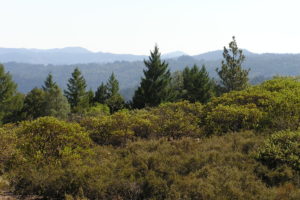California Plans for 2050
 Vibrant Communities and Landscapes
Vibrant Communities and Landscapes
What role can natural lands play in helping California meet its climate change goals? To answer this forward-thinking question, a number of state agencies and departments recently collaborated to draft Vibrant Communities and Landscapes: A Vision for California in 2050. Read more about why natural lands are so important to fighting to climate change and how this vision can be strengthened in our public comments:
September 28, 2016
By electronic submission to: ca.50m@opr.ca.gov
Re: Vibrant Communities and Landscapes: A Vision for California in 2050
Thank you for developing the Vibrant Communities and Landscapes document which does a nice job of recognizing the interconnectedness of well-planned communities in a conserved and well-managed natural landscape. We appreciate the clear recognition that these landscapes play a critical role in resilient carbon storage, climate change adaptation, and protection of biodiversity. The document is also rooted in practicality, with the acknowledgments that appropriate incentives for private landowners and the valuation of ecosystem services can result in tremendous public benefits.
We would like to call your attention to a few slight modifications which we hope might make this forward-thinking document even stronger. Namely, we suggest that this document define resilience for the long term, be clearer that the concept of natural infrastructure also applies to non-urban areas, and ensure that land conservation targets and land management for improved carbon and ecosystem resilience are well integrated.
- Resilient carbon stores should be managed for the long term. The third bullet point of the vision rightly calls for land to be “protected, managed and developed in a manner that maximizes resilient carbon storage.” This is a very worthwhile goal, as land conservation and improved management is one of the most effective tools for sequestering carbon. Terrestrial ecosystems have taken up almost 30% of historical human-caused emissions since 1750.[i] However, the goal could be tweaked slightly to read “maximizes resilient carbon storage over time” as this would recognize that some beneficial management actions (such as prescribed fire) might increase carbon emissions in the short term, but help create forest landscapes with older, more resilient trees.[ii] This change would also encourage short-term restoration projects to be nested within long-term (preferably permanent) land conservation to ensure that the gains in carbon storage endure. Forests in particular need to be managed over very long periods of time (centuries) to maximize carbon storage and resilience.
- Natural infrastructure solutions need not be limited to developed areas. Thank you for recognizing the value of natural and green infrastructure in helping to meet the state’s goals. Natural infrastructure can often be more cost-effective than gray infrastructure solutions, while providing numerous co-benefits. However, this document gives the impression that natural infrastructure is an urban activity, such as planting urban trees or creating rain gardens. While these activities are important for numerous reasons, natural infrastructure is a key concept statewide. For example, restoring and conserving the key source watersheds that supply the state and federal water projects can improve water quality and sometimes quantity, while improving habitat for wildlife and sustaining employment in rural communities. Clarification of this language would prevent future misunderstandings.
- Targets for land conservation are essential and provide for cost-effective reductions of GHG emissions. It is excellent that this vision calls for the state to set quantifiable and achievable goals for land conservation. This is an essential step in ensuring that the goals set forth in the document drive future action. When compared with other state investments in greenhouse gas reduction, forests and other natural lands consistently rank as some of the most cost-effective investments.[iii] In particular, conservation easements on privately-owned natural and working lands can protect more land with less investment than traditional fee-title purchases, while avoiding ongoing management costs to the state. In California, only 15% of the land protection funding from 1998-2008 went to conservation easements, yet 25% of the acreage was conserved with these funds.[iv] Using these cost-effective mechanisms to protect the land can increase the total amount of acreage conserved and result in greater public benefits.
We appreciate this opportunity to offer some suggestions on the well-thought out Vibrant Communities and Landscapes document. We would also like to acknowledge the hard work which effectively bridged siloed areas to create an inclusive and broad-ranging vision that can inform many of the state’s plans. Thank you.
Sincerely,
Paul Mason
V.P. Policy and Incentives
[i] IPCC, 2013: Summary for Policymakers. In: Climate Change 2013: The Physical Science Basis. Contribution of Working Group I to the Fifth Assessment Report of the Intergovernmental Panel on Climate Change [Stocker, T.F., D. Qin, G.-K. Plattner, M. Tignor, S.K. Allen, J. Boschung, A. Nauels, Y. Xia, V. Bex and P.M. Midgley (eds.)]. Cambridge University Press, Cambridge, United Kingdom and New York, NY, USA.
[ii] Earles, J.M., North, M.P., Hurteau, M.D., 2014. Wildfire and drought dynamics destabilize carbon stores of fire-suppressed forests. Ecol. Appl. 24, 732–740. doi:10.1890/13-1860.1
[iii] Legislative Analyst’s Office. 2016. Administration’s Cap-and-Trade Report Provides New Information, Raises Issues for Consideration. Presented to: Assembly Budget Subcommittee No. 3 On Resources and Transportation Hon. Richard Bloom, Chair. Available at: http://www.lao.ca.gov/handouts/resources/2016/Cap-and-Trade-Report-Provides-New-Information-042016.pdf
[iv] The Trust for Public Land, Conservation Almanac, 2016. Available at: www.conservationalmanac.org
[Download comments]
